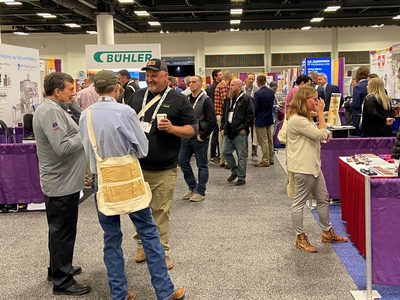Photo courtesy of Bühler.
The need to protect the health of humans and animals by limiting exposure to mycotoxins from grains is increasingly imperative, particularly in light of a recent United Nations (UN) report that confirmed the impact of climate change on food safety and security. It is evident that extreme environmental conditions such as drought and rising temperatures have triggered an upsurge in toxic crops, Bühler said. This dangerous progression was identified as an “emerging environmental issue of our time” by UN Environment Program (UNEP) in a 2016 report: Toxic Crops and Zoonotic Disease. Previously more prevalent in tropical and sub-tropical regions, mycotoxin contamination is now on the rise in temperate regions — meaning it will increasingly become a food safety issue for Europe even if global temperatures may be limited to an increase of only 2-degrees Celsius, which UNEP deems unlikely. Climate change is increasing the prevalence of aflatoxin, one of the most poisonous mycotoxins.
Photo courtesy of Bühler.
“Ultimately, it’s the prevention and reliable removal of mycotoxins as early as possible in the value chain that ensures the safety of foodstuffs produced for all consumer groups,” said Matthias Graeber, expert in mycotoxin reduction and data analytics within Bühler’s Corporate Technology Group.
Finding solutions to mitigate such food and feed safety issues is of critical importance to Bühler. The company invests approximately 5% of its turnover in research and development every year – creating technologies and market-specific solutions to help its customers achieve long-term commercial success despite growing regulatory requirements and regardless of incoming product quality. Bühler has been partnering with science and applied research for many years in order to learn more about the value of integrating cleaning measures along the value chain. One such collaboration is with the experts from the European Horizon2020 project, MycoKey, which was initiated in mid-2016 to develop solutions for reducing major mycotoxins in economically important food and feed chains. The 6.4-million-euro project has partners from 32 organizations from a total of 14 countries in Europe, Asia and Africa. Together with Bühler and some of its customers, MycoKey, has run multiple, large-scale field tests to collect valuable data on the performance of grain cleaning solutions.
A recent research activity specifically looked at the case of ergot alkaloids (EA): To support its industrial milling customers in managing the growing risks associated with mycotoxins, Bühler initiated a study performed at two German rye mills to establish how the level of EA’s can be influenced by grain cleaning and milling processes. The study was carried out by Bühler with two industrial partners, a large milling group and an independent food safety laboratory. Applying the official sampling guidelines of the E.U., 10 rye lots at 12 tons each were tested at two mills.
“Effective reductions of EA concentrations were found for the processing steps: separation by size (Combi cleaner, rotary screen), optical sorting (SORTEX), and surface treatments (scourer with aspirator),” Graeber said. “By far the highest statistical significance of EA reduction could be obtained by optical sorting. This confirms the central importance of optical sorting in the rye supply chain, both at grain reception facilities and in mills.”
The case for reducing levels of mycotoxins of any kind is clear considering the implications on consumer and animal health as well as to the commercial success of milling companies. Bühler said it is focused on to achieve commercially viable yields — regardless of incoming product quality. For example, in a specific case the company has helped an Italian corn producer to recover 70% to 80% of contaminated maize and boost it from biomass to feed grade quality. The company also wants to make an important contribution to reducing post-harvest losses on a global level.







